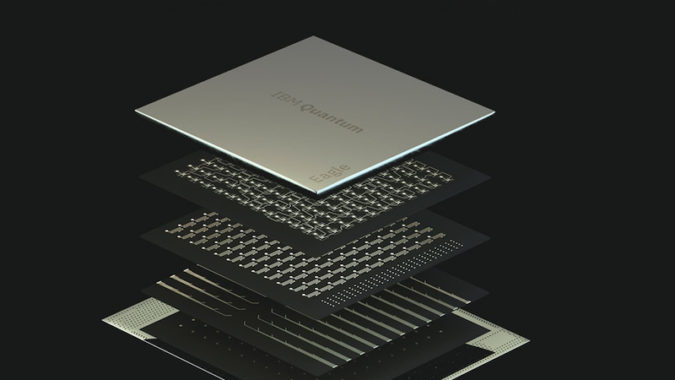IBM last week reported a new technique – entanglement forging – that uses both quantum and classical computing resources to double the size of select simulation problems that can be solved on current quantum computers. The technique partitions weakly-entangled systems into halves simplifying the quantum processing piece of the calculation and leverages classical computing to knit the halves together. In a proof-of-concept experiment, IBM simulated the ground state of a water molecule, representing 10 spin-orbitals on just five qubits of IBM’s 27-qubit Falcon quantum processor.
“We demonstrated a method that in many cases will allow you to run larger problems on your quantum processor than you otherwise could,” said Andrew Eddins, IBM Quantum researcher in an IBM blog and lead author IBM’s paper describing the work. “Entanglement forging provides an efficient method of bringing classical computational resources to bear on quantum problems in a way that, in one respect, doubles your capability. It effectively increases your qubit number by a factor of two, which is really remarkable.”
“There’s a bit of an evolution here,” said IBM Quantum researcher Sara Sheldon in the blog and an author on the paper. “Other groups have worked on similar ideas of breaking up circuits into smaller pieces, either by qubits or in time — like breaking up gates — to do larger problems. Entanglement forging is a particularly scalable method, at least for problems with weak entanglement that have this structure that’s amenable to it.”
Broadly, the entanglement forging technique works best with system comprised of weakly-entangled pieces. This true for many molecular simulations with orbitals that are either spin-up or spin-down, such as water.
As described in the IBM blog:
“The structure of a system or problem plays a crucial role in enabling the entanglement forging technique, which essentially works by dividing systems into two weakly entangled halves, modeling those halves separately on a quantum computer (i.e. first one half, then the other), and then using classical resources to calculate the entanglement between them.
“Here, the phrase “weak entanglement” simply indicates that there are relatively few correlations between the two halves of the original system. This makes entanglement forging a natural fit for the task of modeling molecular systems in cases where there is limited entanglement between the spin-up and spin-down orbitals.”
“For the molecular system of H2O (or other weakly entangled molecules), the two halves we divide it into will correspond to the spin-up and spin-down parts of the molecule. As such, we label those two halves using arrows pointing in the appropriate direction.”
Shown below are two figures (click to enlarge) from the paper, Doubling the Size of Quantum Simulators by Entanglement Forging, published in PRX Quantum two weeks ago; one shows the overall entanglement forging strategy; the second depicts the IBM experiment to measure active molecular orbits in H2O. (A fuller description from the blog is at the end of the article.)
Talking with HPCwire about the work, Sheldon said, “The obvious candidate problems are in the realm of physical simulations. So there’s other molecular problems, which would have this structure (weakly entangled pieces). We also think if you partitioned like a lattice model for something like a physics simulation in space, that could have two halves. I think it’s an interesting question how broadly entanglement forging can be applied. There might be problems in optimization that might be able to make use of the structure.”
Over time the new technique will be incorporated into IBM’s quantum software stack and become part of its quantum serverless programming model intended to take advantage of both quantum and classical resources.
Link to blog: https://research.ibm.com/blog/quantum-entanglement-forging
Link to paper: https://journals.aps.org/prxquantum/abstract/10.1103/PRXQuantum.3.010309
Feature image: IBM’s latest 127-qubit Eagle quantum processor
Brief Description of the IBM Experiment from its Blog
“To start, let’s say we want to simulate some quantum state called psi (in this case, the state of a molecular system like water), prepare that state on a quantum computer, and then perform measurements to learn some property of the state — i.e., to measure an observable of the state such as its energy. We divide this state into its two natural halves, which may share some entanglement.
“For the molecular system of H2O (or other weakly entangled molecules), the two halves we divide it into will correspond to the spin-up and spin-down parts of the molecule. As such, we label those two halves using arrows pointing in the appropriate direction. All of this is illustrated in the first section of the three-part figure shown above.
“Entanglement forging takes a generic circuit that operates on the combined system of the spin-up and spin-down halves, and splits it into smaller circuits that only operate on one half at a time. In other words, the entanglement forging technique takes a circuit operating on 2N qubits, and separates that circuit into two N-qubit halves. (For reference, see the section of the figure shown above labeled “2N-qubit circuit.”)
“From there, researchers then combine the outcomes of these circuits into a summation that is weighted by a list of values that determine the entanglement structure of the original system, i.e., the correlations between the two halves. This is where classical computational resources enter the picture. The classical computer takes care of representing the entanglement structure between the two halves by keeping track of the aforementioned list of values, and those values then determine the smaller experiments the quantum computer must run to learn properties of the entire state.”
































































